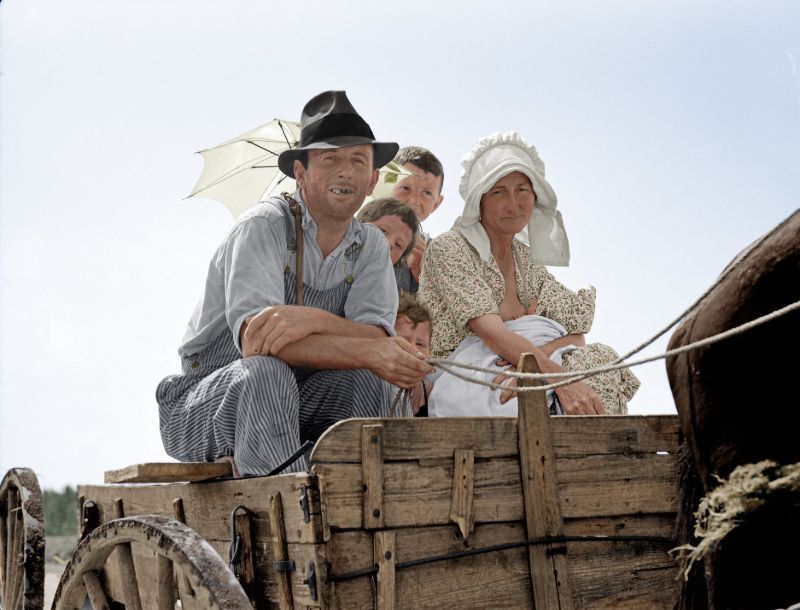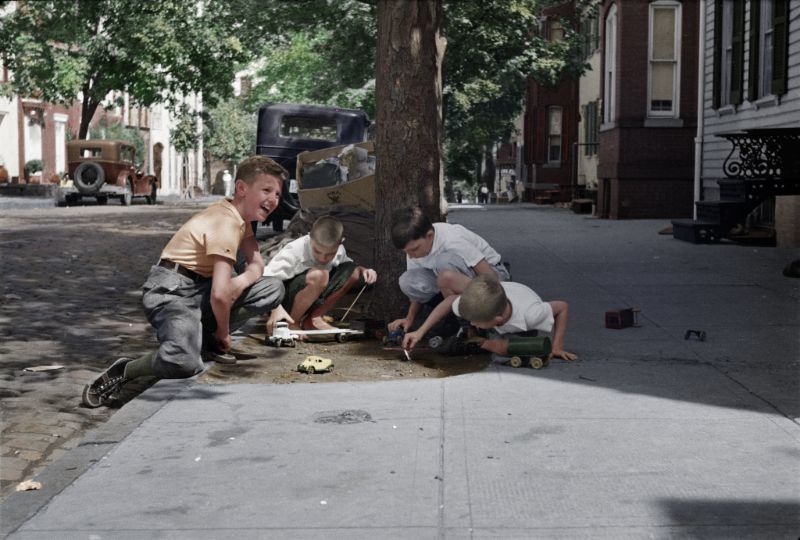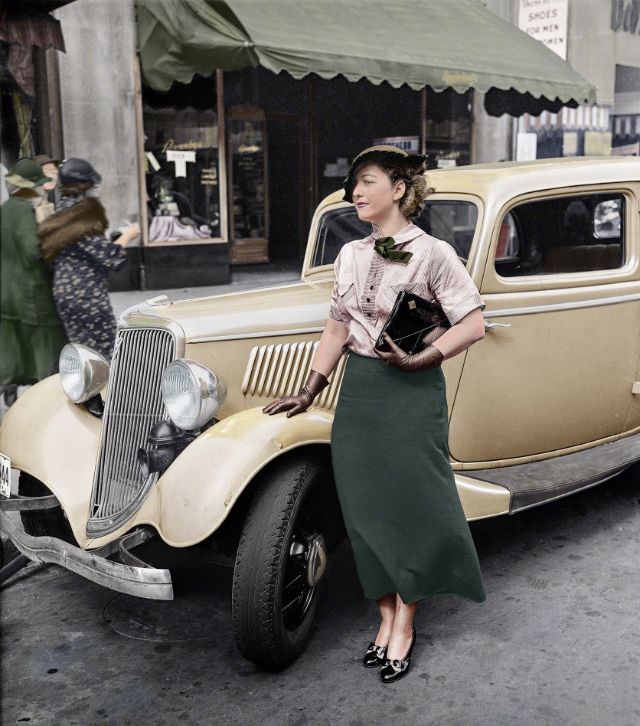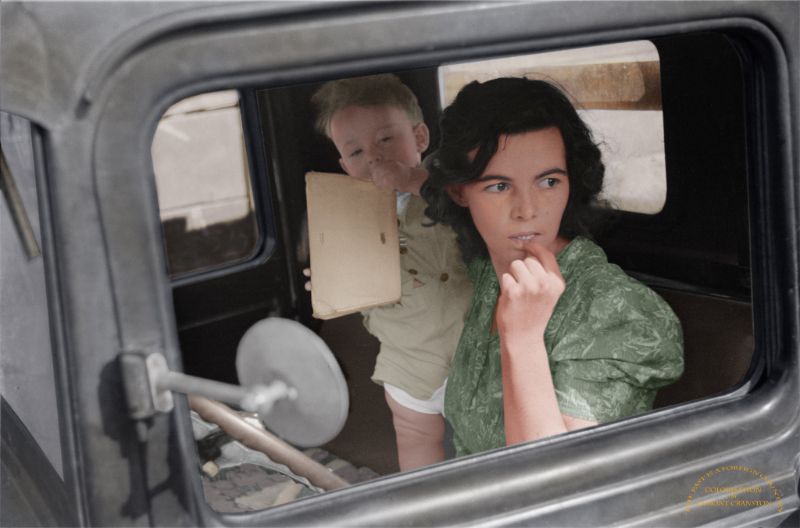 The Great Depression, a somber epoch in American history, is often characterized by the stark imagery of hardship.
The Great Depression, a somber epoch in American history, is often characterized by the stark imagery of hardship.
Traditionally, these images have been captured in grainy black and white, offering a glimpse into an era defined by Hoovervilles, snaking unemployment queues, and individuals waiting in line for a morsel of sustenance.
However, the stunning collection of photographs by the Library of Congress has shattered this monochromatic narrative, revealing the Great Depression in stunning, vivid color.
These captivating images show the resilience of families, the revival of farming communities, and the jubilant moments experienced at state fairs as the nation gradually emerged from its darkest period.
Taken between 1939 and 1941, these pictures portray an America just beginning to mend itself after enduring a catastrophic financial collapse that left nearly 15 million Americans unemployed by 1933.
The images represent a selection from a collaborative effort between the Farm Security Administration and the Office of War Information.
This initiative sought to document the intricate tapestry of American life through a series of photographs captured between 1935 and 1944.

Live fish for sale in Natchitoches, LA, 1940.
The United States embarked on a downward spiral into one of the most severe economic disasters of the 20th century following the stock market crash on October 24, 1929, infamously known as Black Thursday.
This cataclysmic event set the stage for the subsequent Black Tuesday crash, sending shockwaves across the nation.
The precipitous decline of an overheated market was accompanied by a perfect storm of economic calamities, including the widespread collapse of banks, a surge in unemployment rates, and the mass exodus of destitute individuals from agricultural regions in search of employment opportunities.
One visible effect of the depression was the advent of Hoovervilles, which were ramshackle assemblages on vacant lots of cardboard boxes, tents, and small rickety wooden sheds built by homeless people.
Residents lived in the shacks and begged for food or went to soup kitchens. The term was coined by Charles Michelson, publicity chief of the Democratic National Committee, to refer sardonically to President Herbert Hoover whose policies Michelson blamed for the depression.

Trading horses and mules on Jockey Street, Campton, KY, 1940.
The government did not calculate unemployment rates in the 1930s. The most widely accepted estimates of unemployment rates for the Great Depression are those by Stanley Lebergott from the 1950s.
He estimated that unemployment reached 24.9 percent in the worst days of 1933. Another commonly cited estimate is by Michael Darby in 1976. He put the unemployment rate at a peak of 22.5 percent in 1932.
Job losses were less severe among women, workers in non durable industries (such as food and clothing), services and sales workers, and those employed by the government. Unskilled inner city men had much higher unemployment rates.
Age also played a factor. Young people had a hard time getting their first job. Men over the age of 45, if they lost their job, would rarely find another one because employers had their choice of younger men.
Millions were hired in the Great Depression, but men with weaker credentials were not, and they fell into a long-term unemployment trap.

Copper mining in Copperhill, TN, 1939.
The United States’ arduous journey out of the Great Depression showcased the government’s resolute commitment to recovery.
Under President Franklin D. Roosevelt’s leadership, the New Deal unfolded as a comprehensive strategy to reignite the economy, restore employment, and rebuild trust.
The government intervened swiftly, stabilizing the financial sector through the Emergency Banking Act of 1933.
Regulatory bodies like the Securities and Exchange Commission were established to ensure market transparency. Ambitious public works programs such as the WPA and CCC not only provided jobs but also fueled infrastructure development.
Labor reforms under the National Industrial Recovery Act promoted fair practices, while agricultural support measures addressed farming challenges. The Social Security Act offered a safety net, while deficit spending stimulated demand and restored consumer confidence.
The outbreak of World War II further boosted the economy, propelling the nation toward complete recovery. The United States emerged stronger, showcasing resilience and determination in overcoming the darkest chapter in its economic history.

Standing outside Al Capone’s Soup Kitchen, Chicago, IL, 1931. (Colorized by Dana Keller).

A Juke Joint and Gas Station in Melrose, LA, 1940.

The Whinery Family, homesteaders in Pie Town, NM, 1940.

Distributing commodities in St. Johns, AZ, 1940.

In the tenement District of Brockton, MA, 1940.

Lunch break for the sugar cane workers, Rio Piedras, PR, 1941.

Saying grace before the barbecue dinner at the Pie Town, New Mexico Fair, 1940.

Getting ready to serve the barbecue dinner at the Pie Town, New Mexico Fair, 1940.

William London, a railroad worker for 25 years. (1940s).

Schools did not open until the potatoes were harvested. (October 1940).

Harvesting oats, southeastern Georgia (c.1940).

Harvesting corn, Pie Town, New Mexico (October 1940).

Garden adjacent to the dugout home of homesteader Jack Whinery, in Pie Town, New Mexico, 1940.

Fertilizer wagon at an arid farm. (c. 1940).

Homesteader and his children eating barbecue at the Pie Town, New Mexico Fair (1940).

Robstown, Texas (1942).

Faro and Doris Candill in Pie Town, New Mexico, a community formed by migrant farmers from the dust bowl in Texas and Oklahoma. 1940.

Day laborers fight the sun with hats and bonnets as they pick cotton near Clarksdale, Mississippi in 1939.

Migratory workers hang out at a ‘juke joint’ during a slack season in Belle Glade, Florida in early 1941.

Son of a woodcutter, Eden Mills, Vermont, August 1936. (Colorized by Lamont Cranston).

18 year-old mother from Oklahoma in California, March 1937.

Anton Weber, a resettled farmer, Tompkins County, New York, September 1937. (Colorized by Lamont Cranston).

Men on “Skid Row”, Modesto, California, March 1937. (Colorized by Lamont Cranston).

Sharecropper family, Hazlehurst, Georgia, July 1937. (Colorized by Lamont Cranston).

Wife and child of an itinerant cane furniture maker, Wagoner County, Oklahoma, June 1939. (Colorized by Lamont Cranston).

Street kids at play, Georgetown, Washington D.C., Summer 1935. (Colorized by Lamont Cranston).

Street smart, Washington, D.C., 1935. (Colorized by Lamont Cranston).

Biker girl, summer 1937. (Colorized by Lamont Cranston).

A farm wife waits for her husband at a farm auction near Oskaloosa, Kansas, October 1938. (Colorized by Lamont Cranston).

Father and daughter, 1939. (Colorized by Lamont Cranston).





